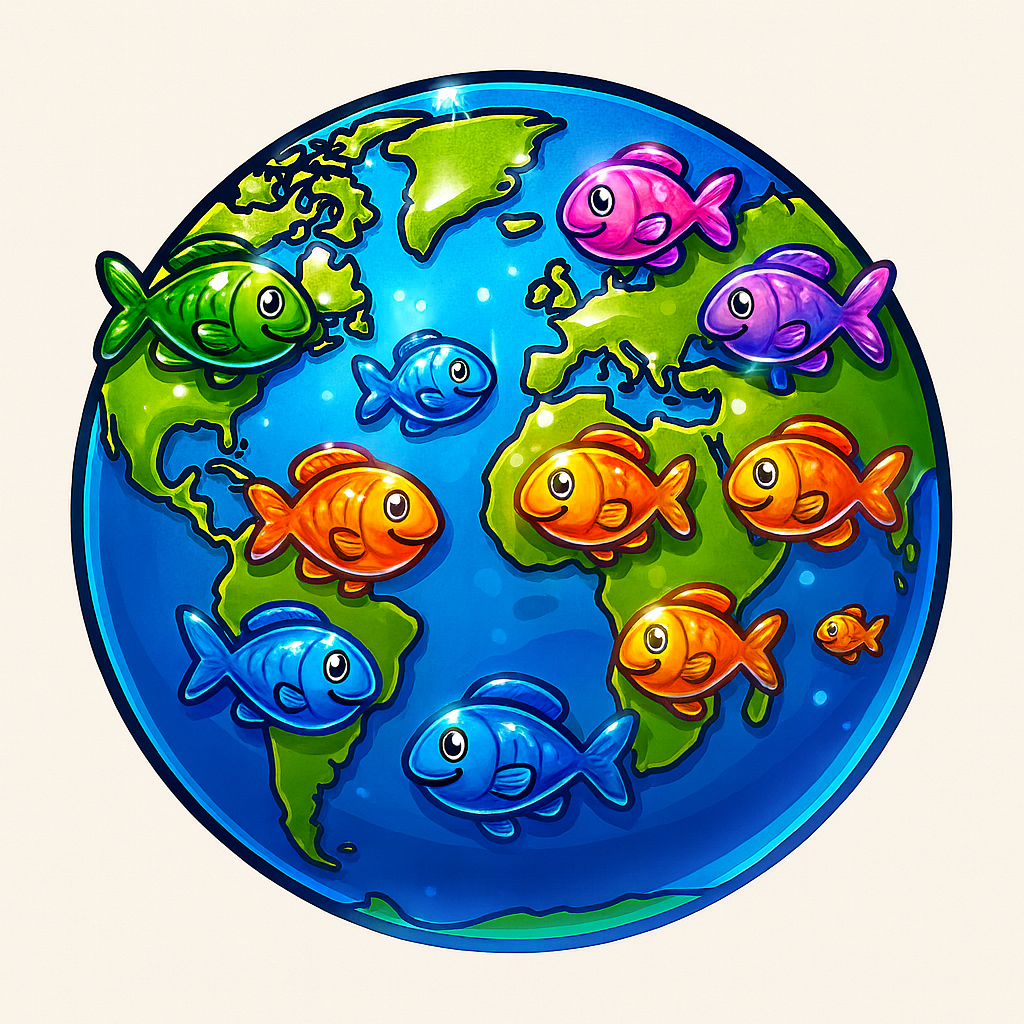Where do aquarium fish come from?
🌍 Wild-Caught Fish
- Origin: Collected directly from rivers, lakes, and oceans around the world.
- Hotspots:
- Amazon River Basin (South America): Home to neon tetras, discus, angelfish, plecos.
- African Rift Lakes (Lake Malawi, Lake Tanganyika, Lake Victoria): Famous for colorful cichlids.
- Southeast Asia: Source of many loaches, rasboras, and wild bettas.
- Pros: Natural genetics, stronger coloration, unique species not yet bred in captivity.
- Cons: Stress from capture and shipping, risk of overfishing, and potential disease introduction.
- Fun Fact: Some rare plecos and stingrays are only available as wild-caught because they’re very hard to breed in captivity.
🐠 Captive-Bred Fish
- Origin: Raised on fish farms, breeding facilities, or hatcheries.
- Major Hubs:
- Florida (USA): Massive outdoor ponds for livebearers (guppies, mollies, swordtails).
- Southeast Asia (Thailand, Singapore, Indonesia): Known for bettas, gouramis, and ornamental fish.
- Eastern Europe: Produces goldfish, koi, and some rare cichlids.
- Pros: Healthier, disease-resistant, accustomed to aquarium life, and more sustainable.
- Cons: Sometimes selectively bred too much (can weaken genetics or create deformities).
- Examples: Bettas 🐟, Angelfish 👑, Guppies 🌈, Discus 🎨, and most community fish are farm-bred.
👩🌾 Local Breeders & Hobbyists
- Who: Passionate aquarists breeding fish at home or in small facilities.
- Benefits:
- Fish are already adjusted to local tap water 💧.
- Often hardier since they’re raised in smaller numbers.
- Supports local communities and small businesses.
- Examples: Plecos 🪵, African cichlids 🎨, fancy shrimp 🦐, and unusual livebearers.
- Fun Fact: Many rare color morphs (like albino or long-fin variants) started in hobbyists’ tanks before becoming popular worldwide.
🏭 Wholesalers & Exporters
- Role: Middlemen between collectors/breeders and pet stores or online shops.
- Process:
- Exporters in South America, Asia, or Africa collect/breed fish.
- Shipments go to wholesalers worldwide.
- Wholesalers distribute to local fish stores, chain pet shops, and online sellers.
- Scale: Some wholesalers handle millions of fish per month, ranging from common guppies to ultra-rare species.
- Note: Fish are often quarantined here before being sold to ensure they’re healthy.
🚫 Illegal or Questionable Sources
- While less common, some fish may come from unsustainable or illegal collection practices.
- Example: Endangered species being smuggled out of South America or Asia.
- Many countries now enforce CITES regulations to protect rare and threatened species.
✅ Summary:
- 🌍 Wild-caught = unique but less sustainable.
- 🐠 Captive-bred = hardy, common, eco-friendly.
- 👩🌾 Local breeders = hardy, adapted to local water, great variety.
- 🏭 Wholesalers = supply chain backbone, distributing fish globally.
| Source | ✅ Pros | ⚠️ Cons | 🐠 Examples |
|---|---|---|---|
| 🌍 Wild-Caught | - Natural genetics & strong coloration 🎨 - Rare species not bred in captivity 🌟 - Maintains natural diversity 🌱 | - Stress & high mortality during capture/shipping 🚢 - Risk of disease/parasites 🦠 - Can harm wild populations if unsustainable ❌ | Neon Tetras, Wild Discus, Plecos, Stingrays |
| 🐠 Captive-Bred (Fish Farms) | - Healthier & adapted to aquariums 🏡 - Reduces pressure on wild populations 🌍 - Steady supply, often cheaper 💲 | - Selective breeding can cause deformities 🌀 - Less genetic diversity 🧬 | Guppies, Angelfish, Bettas, Koi, Discus |
| 👩🌾 Local Breeders/Hobbyists | - Hardy & already adapted to local water 💧 - Support small businesses ❤️ - Unique strains & color morphs 🌈 | - Limited availability 📦 - May be more expensive 💵 - Quality depends on breeder ⚖️ | Plecos, African Cichlids, Fancy Shrimp |
| 🏭 Wholesalers/Exporters | - Wide variety from common to rare 🐟 - Quarantined before sale 🩺 - Distribute globally 🌐 | - Fish may be stressed from long supply chain ✈️ - Health can vary 🦠 | Mixed (from guppies to rare exotics) |
✅ Quick Tip for Hobbyists:
- If you’re after common community fish → Go for captive-bred.
- If you want rare or unique species → Often only wild-caught is available.
- If you want healthy, locally adapted fish → Choose local breeders.
- If you want bulk or variety → Pet stores & online sellers often get theirs via wholesalers.

Powered by Lightspeed
Display prices in:USD